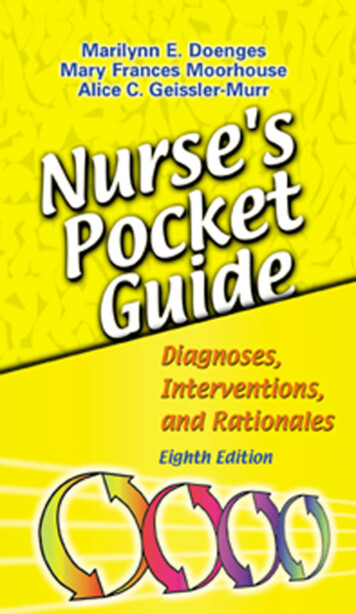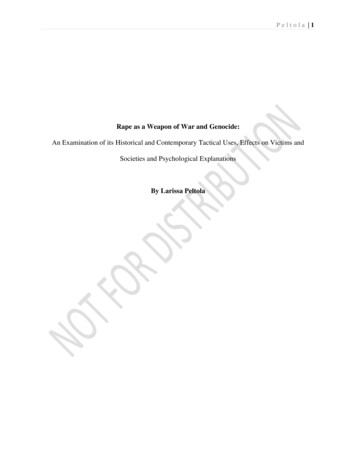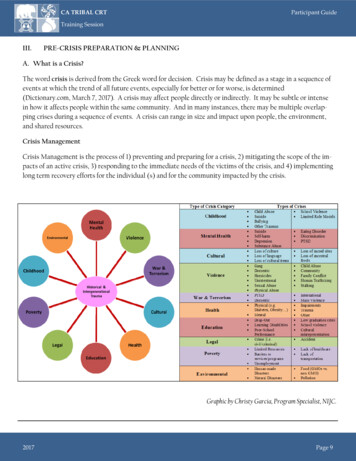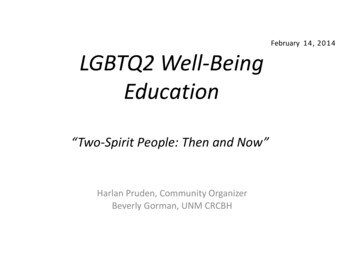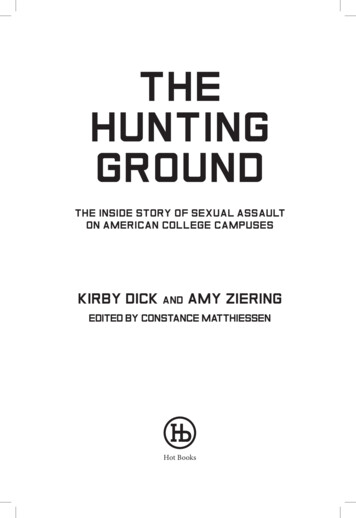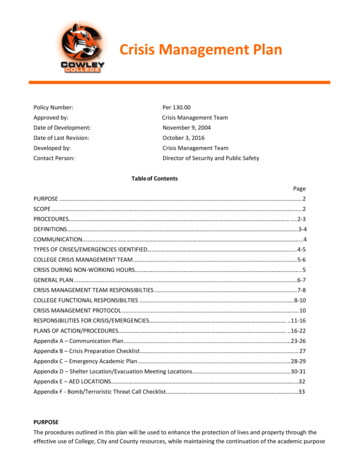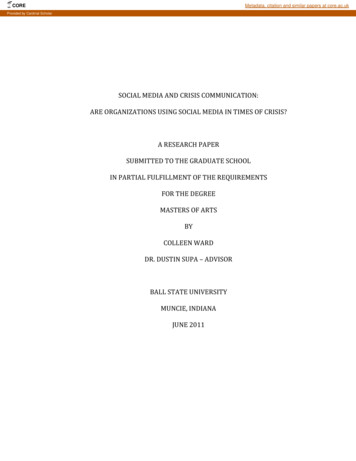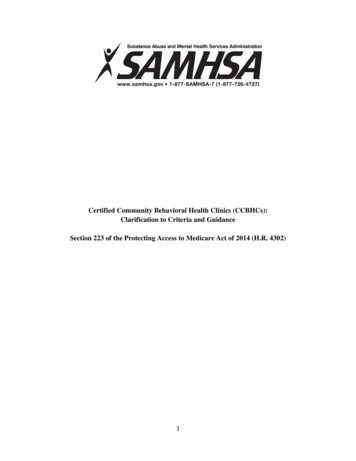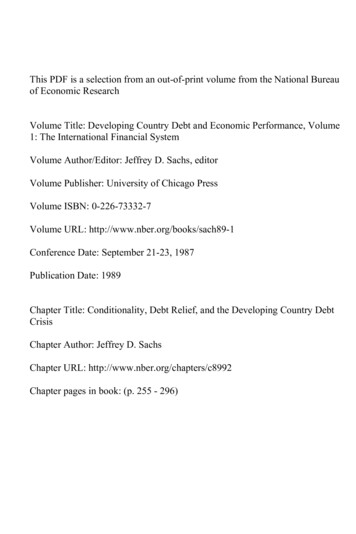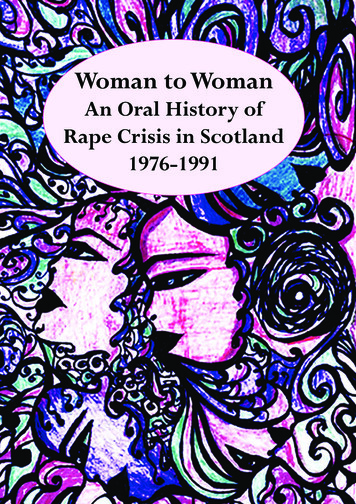
Transcription
Woman to WomanAn Oral History ofRape Crisis in Scotland1976-1991
Woman to WomanAn Oral History ofRape Crisis in Scotland1976 –1991Edited by Eileen Maitland
Published by Rape Crisis Scotland 2009Tara House, 46 Bath Street, Glasgow G2 1HGCopyright Rape Crisis Scotland 2009ISBN 978-0-9561486-0-5Cover illustrations by kind permission of Angela Hayden –http://angelahayden.net/Front cover: Circle of WomenBack cover: BW Woman#4Printed by Hampden Advertising Ltd
DedicationThis book is dedicated to all women who have been involved in thefight against violence against women.In particular, it is dedicated to Frances Oboyle, Kate Cavanagh andIngrid McClements, whose contributions to this movement wereimmeasurable.3
ContentsAcknowledgements .8Introduction .9Early Days .10The First centres.14Glasgow .14Advertising & Fundraising .16Every Woman’s Fear .22Women’s Support Project .23Women’s Safety Centre .23Edinburgh .25Aberdeen .35Revival.47Dundee .51Highland Rape Crisis .56Kilmarnock .59Central Scotland Rape Crisis .63Recruitment .65Learning to support and developing support skills .68Face to face support .76Support for supporters .78Training .80Contribution of survivors to Rape Crisis .82Child sexual abuse .85Incest Survivors Groups .89Action Against Incest .91Safe, Strong & Free .94Ritual abuse .965
Feminism/feminist ideals .99Collective working . 101Investigation & prosecution of rape : the reality . 110Police questioning . 111Forensic examination . 112Judgemental reactions . 114Rape Crisis support in court . 115Rapists & “real” rape . 116Righteous victims and other women . 117The Glasgow Rape Case . 118Judges: attitudes & comments . 119Jury attitudes . 121Women held responsible . 121“False” accusation . 122Ignorance of the impact of abuse . 124Lack of representation . 124No opportunity to examine the accused . 125Conviction & sentencing . 126Lawyers’ attitudes . 127Research into sexual history & character evidence . 128Criminal injuries claims . 131Spreading the word: talks and training . 132Police training . 133WACUs and FACUs . 137Campaigning . 141Newspapers . 141Sex shop in Aberdeen . 141GRCC takes to the streets . 142Films . 1436
Campaigning (ctd.)Legal campaigning . 144Rape in marriage . 144Laws of evidence . 145Criminal injuries compensation . 146Pornography . 147Reclaim The Night . 147Greenham Common . 151Language . 153Conferences . 155Cardonald 1987 . 157Ritual Abuse 1989 . 159How Rape Crisis was perceived . 160Role of the media . 164Professional prejudice & conflict . 167Development of the Rape Crisis Network in Scotland . 169The debate around supporting men . 171The wider feminist network . 172Lesbian women . 173Black & minority ethnic women . 175Anecdotes . 176Influences: reading . 178Testimony the personal impact of Rape Crisis Work . 180Friendship & social contact . 183Challenging people in everyday life . 185Mothers and daughters . 187Perceptions of Rape Crisis in Scotland today . 188Looking forward . 191References . 1957
AcknowledgementsOur heartfelt thanks go out to every woman who took the time to take part in this oralhistory project, and to every woman who played a part in the development of the RapeCrisis movement in Scotland. We hope that their voices will help:“To inspire younger women, younger generations to keep on, not so much a struggle, but a sort of anopening of the mind, a strengthening of the connection between women and a better understanding ofthe world around us and that a lot of good things can and will go on happening. But not to sort ofsleep on our laurels the way sometime women think these days that they’ve got it all because it’s not true.It could be taken away so easily.“ [Florence Germain]We would also like to thank Professor Dorothy Griffiths and the Feminist Review Trustfor funding this publication, and for their patience and support, Angela Hayden for verygenerously allowing us to use her beautiful images on the cover, Sean Feeny at HampdenAdvertising for support and advice on preparation for printing, and Anne Muir forextensive use of recording equipment for carrying out the interviews, and advice on goodpractice in oral history and file preservation.8
Introduction : The way out is to tellHealing is a continuous process.Rape affects all aspect of one’s life and being and one has to work continuously to become whole and intact.Pieces of myself are coming slowly together. I am different, but I accept that.The way out is to tell:Speak of the acts perpetrated upon us, speak the atrocities, speak the injustices, speak the personal violations of thesoul.Someone will listen, someone will believe our stories, someone will join us.Charlotte Pierce-Baker – author of Surviving the Silencehttp://www.survivingtothriving.org/quotesOn 27th November 2006, over 100 women gathered at the City Halls in Glasgow for a celebration. Thismoment was the culmination of 30 years of commitment, care and concern, clamouring and campaigningthat characterised the Rape Crisis movement in Scotland, from its first determined steps in the mid 70’s,to the fully-fledged feminist support organisation and force for change it is today. Many of the womenwho attended the party that night were among those whose efforts at the very beginning had made itall possible. This document puts together the testimonies of many of the women involved, and tells thestory of why and how the Rape Crisis movement emerged in Scotland, and what it meant to them tobe part of this unique piece of Scottish herstory.The 2006 anniversary brought sharply into focus all that had been achieved in the course of the precedingthree decades, and the emphasis it placed on the scale of that achievement seemed to highlight theimportance of documenting the process, and the memories of those women who shaped it. As a result,Rape Crisis Scotland decided to undertake an oral history project, and recorded a total of 33 interviewswith women in Glasgow, Edinburgh, Aberdeen, Dundee, Inverness and further afield. In offering uptheir testimonies, these women bore witness to the determination and commitment which gave birthto the Scottish Rape Crisis movement: a birth no less painful or fraught with anxieties than any other– and often just as rewarding.NoteThis document is by no means an exhaustive account of the experiences of women who were involved inRape Crisis in Scotland during its first 15 years.There are many women whose names and contributionsremain unrecorded but who nevertheless played just as significant a role as the women whose testimonyis documented here. Their words pay tribute to the determination, resilience, ingenuity, courage andcompassion of all the women whose monumental efforts forged the Scottish Rape Crisis movementwhich continues the fight against sexual violence today.9
Early days:Motivation, planning, and involvement –by design and by chanceThe individual centres emerged in very different ways – some were the result of months of planning,while others sprang up virtually overnight, and developed on much more of an ad hoc basis. All of thecentres developed to some extent on a praxis model – their shape and service model being formedin response to the needs of their service users, though inevitably circumscribed by the extremelylimited resources that were available to them. The first services began in the major cities of Scotlandand served mainly women in urban areas in the early days. However, this is not to say women in ruralareas were neglected: although the advent of centres such as those now established in Argyll andBute, the Western Isles and Perth and Kinross seemed like a distant dream in the mid-70’s, the fewservices that did become established during this period often went to great lengths to support womenat considerable distances from their urban bases. Indeed, centres such as Glasgow, particularly duringthe period it was funded by Strathclyde Regional Council and was known as Strathclyde Rape CrisisCentre covered vast geographical areas and travelled widely to provide support to women outwiththe cities.Statistics published in The Glasgow Herald at the end of 1980 showed that there was growing concernover a conviction rate that stood at around 23% of the number reported – in 1979, when 145 caseswere reported (90 of these were in Strathclyde), 50 were proceeded against, and 34 of these resulted ina conviction. It seems horribly ironic that this rate of conviction now seems like a distant ideal – figuresfor 2006/7 showed that while the figure for reported rapes rocketed in the intervening years to 922, thenumber of corresponding convictions was a mere 27, giving Scotland at the time of publication almostthree decades later one of the lowest conviction rates anywhere – 2.9%.Motivation: the prevailing cultureMany of the women who became involved in Rape Crisis had been involved in left-wing politics, butwere disillusioned with the way that issues of gender were sidelined or ignored. The failure of otherpolitical systems to take account of the realities experienced by women, pushed many towards the whollyfeminist agenda underpinning the Rape Crisis movement:“We had the broad left, we had the Socialist Workers Party, we had the International Marxist Group We had all shades of red. As long as it was red, it was there and, but within that, not really an awfullot of discussion of where women fitted in. The issue was class, and we didn’t even really talk aboutpoverty. We talked about class and Capitalism. And there wasn’t any recognition of where gender orrace or disability where any of those issues sat within that understanding of what society was about.”[Lily Greenan]“I was very politically active, but I’d been involved in party politics, and you know, they were so sort ofmale dominated and confrontational and men scoring points off each other, you know, that I felt that alot of the wood wasn’t being seen for the trees I mean, the women’s movement and women’s issueswere raised, but really, it was a bit of a struggle and there wasn’t the focus that I wanted I wantedto focus more on the needs of women rather than try and fight it from a party political perspective I thought I want to be somewhere where people, more or less, were all aiming in the same direction,you know?” [Rona Clarke]10
“I think like many women I’d been very interested in feminist politics during the seventies but hadn’tbeen very active I had kinda been more at the edges of it and I was in my twenties it just was a kindof coming together of, you know, wanting to join a women’s group, knowing that I felt very stronglyabout sexual violence in particular against women and children, and wanting to join women who wantedto do something. I mean, it was as simple as that, really.” [Siobhan Canavan]“I suppose it came about because I had become interested in the Women’s Movement generally andhad been involved in things like the pro-abortion campaign and just generally meeting up with otherwomen and talking about issues that, you know, we hadn’t talked with other women about in the past”[Moira Kane]“I got involved because I was really quite political as a young woman. So anything with supposedly leftwing politics and injustice and humanity, humanitarian issues really interested me. And the first thing Idid when I left home was to work in an organisation called Simon Community which supported homelesspeople. And it was very, the project I was in, in the community was very much geared towards men,which was really good and it was supporting them to kind of have like sober and healthy lives. But itwasn’t enough. And I heard about Rape Crisis and volunteered.” [Heather Forrest]“I’d already been quite involved in some of the other aspects of what the women’s movement inEdinburgh had been doing, so I’d been involved in the regional women’s liberation group that formedin Edinburgh probably around sort of ’70, ’71, and also been involved in a group which was called,rather grandly, the Women’s Legal and Financial Independence Group, that had met, done a bit of workaround various sort of issues around employment and also family law issues I’d had some, less directinvolvement with Women’s Aid, which really started to operate, in Edinburgh, from about ’73, ’74 So it was a sort of natural progression, I think, probably, from that and the issue had become quitebig” [Sheila Gilmore]“Definitely considered myself a feminist at the time. All my friends were feminist I was in a bookgroup and that was a feminist book group and we only read women writers it was definitely politicalin those days and I think that’s probably what motivated me.” [Brenda Flaherty]“When I was at University in England, I was on Nightline and then when I lived in London for a fewyears I was a Samaritan helper, and then when I came up here I phoned the Samaritans and they didn’twant me, so I suppose I was looking for something else to do and the Women and Health group wasvery good. Where you met lots of people and they were feminists as well so when that ended, naturallyprogressed towards Rape Crisis.” [Maureen Porter]“Nightline was already in existence that was a student body thing it was from my doing that asa volunteer, I think, that started opening my eyes up to the issues around rape but it was not aspecialist line for people who had experienced that Samaritans gave us training so that was veryuseful.” [Kathy Litteljohn]“I don’t know what happened out in society there, but it did change and people now will come – they’rewanting to add it to a CV or they’re wanting counselling experience – that’s become very popular – butnot then.” [Norma Benzie]Sometimes, involvement in Rape Crisis work developed out of unusual or unlikely circumstances:“Actually I had a boyfriend that suggested it I was quite young – I would be just turned 18 I think, andthis was actually my first boyfriend. I remember meeting him at a dance, and thinking I won’t dancewith him a second time, I’ll just get rid of him I thought one of the things that would get rid of himwas if I told him I was a feminist and he said “Oh do you read Spare Rib?” and I had never actually seena copy of Spare Rib but I’d heard of it and I quite fancied reading it. So I started going out with him and11
felt emboldened to get a copy of Spare Rib and I think he actually saw a notice up about Rape Crisis inGlasgow looking for volunteers – this would be 1979, so I phoned up and after a while I think he thoughtI was getting a bit too involved – that’s how I got involved with Glasgow.” [Morna Findlay]And personal experiences of the ever-present threat of sexual violence were another majormotivating factor:“Being groped was so commonplace that you just didn’t even register it. You just kinda went “Ohfuck” you know “bastard” you know, you kinda swore a bit but you didn’t let it get to you because youcouldn’t, ‘cause it was so commonplace. Sexualised comments being commented on by completestrangers was the norm. So you just got on with it.You might be irritated by it, you might be annoyedby it, but you didn’t react to it. I think I’d begun to react – I’d begun to get quite pissed off about it.”[Lily Greenan]But the reasons for the interest and commitment that so many women gave to Rape Crisis centres wereas complex and diverse as they were themselves:“Some women came in because they were rape survivors [ ] was somebody who was absolutely therefor the support of women.she was a rape survivor herself, and she was an absolute backbone terrificwoman. And others would come in because they were looking for like-minded women. Sometimesbecause they thought they might be lesbian, but didn’t know what to do about it, and that worked verywell sometimes, and sometimes it didn’t for them Others came in, because intellectually, perhaps,they really wanted to do something, or politically, they wanted to do something, and others came in‘cause they wanted to change the world.” [Aileen Christianson]Helen Mackinnon had just returned from 6 months travelling in India, Nepal and Sri Lanka in 1979when she joined the Rape Crisis centre in Edinburgh:“I had always been interested in women’s issues and health issues. But when I was away travelling, itsort of gave me time to have a good think and it certainly – through looking at what was going onin India and Nepal and Sri Lanka at that time issues around poverty, women’s position as part of thatand even like the reading that I was doing when I was away, it really fired me up to think that I neededto do something more immediate around issues, women’s issues when I got back once I did get back,I thought that Rape Crisis was a nice mixture because it was offering practical help as well as politicallobbying. And so that’s what I did.And it was funny because when everybody else was sort of joining feminist groups in my early 20s,because by that time I think I was about 29 or 30. In my early 20s I was training to be a nurse, I was atuniversity and then I was doing nursing and then I was like a ward sister and I was heavily involved inthe health service. And I was more like, not an onlooker, but I felt more peripheral to the sort of majorfeminist movement that was going on at that time so I kind of felt almost like a late starter.” [HelenMackinnon]She recalls her memories of the first of many visits to Broughton Street:“The first introduction was at a meeting, it was a Saturday, and there was people from all over Scotlandthere to talk about Rape Crisis there was women knitting and it was also a very cold room And Iremember that’s when I first met Jan, Jan MacLeod. She was there and she must have just been a young,young woman it was just her I remember and Aileen.” [Helen Mackinnon]Helen spent around 9 months with Edinburgh Rape Crisis before she moved through to Glasgow totake up a new post:12
“It was quite intensive though because at that time I didn’t have a job. So it meant that I was on therota I did manage to invest quite a lot of time in it, which was really, really good I wasn’t sort ofdoing a day job and then rushing. And it felt really like one of the most important things in my life to doit it really sort of, hit the spot in terms of it being meaningful and making me feel good. And whatI learnt in these first six months was to be continued once I went to Glasgow. “ [Helen Mackinnon]Dorothy Degenhardt’s experiences took her on a similar path to Helen’s:“I took a year out of work which would be ’78–’79. And I travelled in India and Pakistan and Kashmirand Bangladesh and became more aware of the position of women in those countries and then I realisedwhen I got back that actually it was similar for some women in Britain. And then I became much moreinvolved, or interested in women’s issues and feminist stuff I came back and worked in a hostel inEdinburgh for people coming out of psychiatric hospital and prison, and then again, there was a newwomen’s hostel being set up in Edinburgh for women offenders, an alternative to prison or womencoming out of Cornton Vale and I was in at the beginning of that. So that will be ’82–’85, the majorityof women that worked there were feminists. And we tried to run it, which was very challenging, as afeminist collective Being interested in women’s issues and then the follow on from that was gettinginvolved in Rape Crisis.” [Dorothy Degenhardt]13
The First CentresGlasgow [Jane Dorby, 1976-c1984,Jan Macleod, 1977-1985, Anita Grassey, Naomi Gibson, LorraineWarmbath, Liz Hunter, Morna Findlay, 1979-82, Helen Mackinnon, 1981-85, Rona Clarke, c1980/1/2?,Isabelle Kerr, 1980-82, 1985-90 & 2006-, Frances Monaghan (Action Against Incest), 1982-89, Rhona Watson(Action Against Incest), Kathy Litteljohn, 1975-6, Ann Hamilton, Caroline Armit, 1977-1985, Heather Low,Heather Forrest, 1983-89, Marcia D’Oliveira, Patricia Bell, Sheila Inglis, Alison Hack, Susan Gibb, IreneAudain, Dorothy Kemp, Dorothy Brownlie, Kate Laverty, Maria Laverty, Sheila Brodie, 1987-97, Lesley Ross,Linda Reid, Lyn Harvey, Morag McSween, Angela McCusker, Julie Harkin, Irene, Pauline.]Glasgow Rape Crisis, which was the first centre in Scotland, emerged from a Women’s Group atGlasgow University:“Well my understanding is that it grew out of the Glasgow Women’s Group that they had a women’sgroup or a women’s liberation group in Glasgow and round about 1975.it split into different interestgroups. And one of them was about rape and it turned into the Rape Crisis Centre and one of them wasabout domestic violence and it turned into Glasgow Women’s Aid. And then they had other ones thatwere to do with employment rights and abortion rights.” [Jan Macleod]Jane Dorby, who had already been involved with the women’s movement in London by the times thishappened in 1976, recalls:“I came up to Glasgow and I was studying and working, and I met a person called Naomi Gibson. AndNaomi had said they were interested in starting a Rape Crisis centre, but I initially got involved in thewomen’s group at Glasgow University and we used to meet on a fortnightly basis, and we woulddiscuss feminist theories, and there was a very strong split in the group for abortion campaigns andRape Crisis, and I chose to establish, along with Naomi and a few others, the Rape Crisis Centre. So wemanaged to get a small premises in Holland Street. And we got the phone lines up and running and wekept that kind of very maintenance establishment thing.” [Jane Dorby]“The Scottish Council for Civil Liberties had a little office on the ground floor of a close in HollandStreet. And we just had a phone in there, it wasn’t even our own room we just were allowed to go in toone of their office rooms, we used to do evening rota, Monday, Wednesday and Friday and sometimesSunday. And literally all that they had was the phone and an answer phone and a notebook. So we werethere for a while, but I mean the good thing about it obviously was it was rent free. And then they moveddown to Hope Street, which was with the Volunteer Centre and they gave us more or less the samearrangement, we had access to a desk and a meeting room.” [Jan Macleod]“Someone knew someone in Civil Liberties, very, very nice people at the time, and they had a spareroom. It was Civil Liberties who rented it, and they gave us a back room free the only thing we’dto pay for was the phone line. So we shared it with civil liberties – it was actually very good, therewas a good network there, because they had lawyers and things as well, and people we could get incontact with.” [Jane Dorby]A small piece in the Glasgow Herald under the headline “Funds needed”, from February 1978 highlightedthe difficulties with accommodation that were faced by the Glasgow centre:“After frustrating months of having no fixed address the Glasgow Rape Crisis Group now occupiespremises (albeit small and temporary) in the city centre and can now make some start in helping rapevictims seek justice and begin mending their lives. Meanwhile, the search for more suitable premises14
will continue and, of course, funds will be urgently needed to ensure that the group’s therapeutic andpractical counselling becomes a long term project.If you think you can help, or if you need help, please contact the group c/o The Citizen’s Advice Bureau,212 Bath Street, Glasgow G2 (041-331 2345/6/7)” [The Glasgow Herald, 15th February 1978]“It was this tiny little cubby-hole office and I remember I fitted a mortice lock to it and then afterthat we moved to the Volunteer Bureau in Wellington Street for a while we really were virtually ina cupboard we’d go in about half past 6 or whatever and unlocked a big cupboard the phone lineand the answering machine was in the cupboard that and our books – logs, diary and whatever setup on a table ” [Caroline Armit]Kathy Litteljohn recalled her own involvement at the very earliest stages of Glasgow Rape Crisis:“I worked in Nightline, at Strathclyde University I was a student doing languages and psychologyat Strathclyde between ’73 and ’76 it was in about the end of my university course at Strathclydein about 1975 It was very much at the start with Jane and Jan it was before we’d even been ableto get funding We started going to Holland St because SCCL gave us a little dingy room to meetin I was in the Nightline and between our experience of calls there and information in thepress about some really high profile cases that were going on with really huge issues
over a conviction rate that stood at around 23% of the number reported - in 1979, when 145 cases were reported (90 of these were in Strathclyde), 50 were proceeded against, and 34 of these resulted in a conviction. It seems horribly ironic that this rate of conviction now seems like a distant ideal - figures

